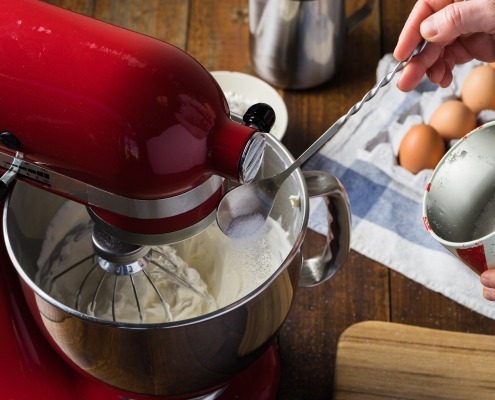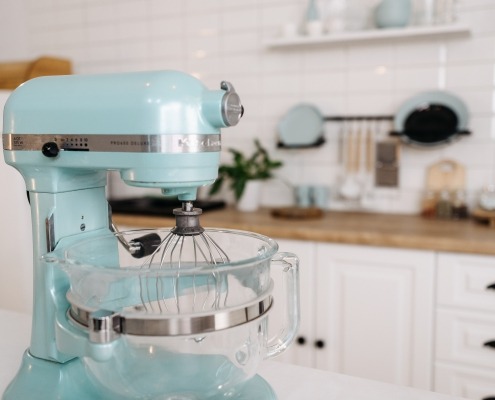Why does my KitchenAid stand mixer overheat and how can I prevent it?
Steven E / Friday November 8, 2024
Your KitchenAid stand mixer is an indispensable helper in the kitchen, effortlessly kneading dough, whipping cream, and mixing batter. But what happens when it starts to overheat? An overheating mixer can halt your culinary creations and may indicate underlying problems that need addressing. In this article, we’ll explore the common reasons behind an overheating KitchenAid stand mixer and provide practical tips to prevent it.
Common reasons why your stand mixer overheats
Overloading the mixer bowl
Overloading the mixer is a common cause of overheating. Each KitchenAid stand mixer has a recommended capacity limit. Exceeding this limit forces the motor to work harder, generating excess heat.
- Check the user manual for the maximum capacity of your model.
- Avoid doubling recipes that may exceed the mixer’s capacity.
- Mix heavy doughs like bread or pasta in smaller batches.
Prolonged use without breaks
Running the mixer continuously for extended periods can cause it to overheat. The motor needs occasional breaks to cool down, especially when handling heavy mixtures.
- Limit continuous operation to 10 minutes for heavy mixtures.
- Allow the mixer to rest for at least 20 minutes after intensive use.
- Monitor the mixer’s temperature by feeling the top of the unit; if it’s warm, it’s time for a break.
Lack of regular maintenance
Like any appliance, your stand mixer requires regular maintenance to function optimally. Neglecting maintenance can lead to overheating and other performance problems.
- Keep the mixer clean by wiping it down after each use.
- Periodically check and replace worn parts, such as gears and brushes.
- Lubricate moving parts as recommended in the user manual.
- For detailed maintenance tips, visit our guide on How To Clean And Maintain Your Stand Mixer.
Troubleshooting an overheating stand mixer
Check the cooling fan
The cooling fan helps dissipate heat from the motor. If it’s obstructed or malfunctioning, the mixer can overheat.
- Ensure that the fan blades are clean and free of debris.
- Spin the fan manually to check for smooth operation.
- If the fan is damaged, replace it with a compatible part.
Inspect the motor brushes
Worn or damaged motor brushes can cause the mixer to overheat. These brushes conduct electricity to the motor’s armature and are essential for proper operation.
- Unplug the mixer and remove the motor housing according to the user manual.
- Find the motor brushes on either side of the motor.
- Inspect the brushes for wear; they should be at least 1/4 inch long.
- If the brushes are worn down, replace them with new ones. You can find compatible KitchenAid mixer parts on our website.
- For a step-by-step guide, watch our tutorial on How To: Whirlpool/KitchenAid/Maytag Motor Brush Replacement.
Test the motor windings with a multimeter
Damaged motor windings can cause excessive heat due to abnormal electrical resistance. You can test the windings using a multimeter. It’s important to measure the specific resistance values; continuity testing is insufficient for diagnosing issues where precise measurements are necessary.
- Unplug the mixer and disassemble it to access the motor.
- Set your multimeter to the resistance (ohms) setting.
- Place the probes on the motor terminals to measure resistance.
- Compare the measured resistance with the manufacturer’s specifications. A significantly higher, lower, or infinite resistance reading indicates a problem.
- If the motor windings are faulty, consider replacing the motor.
- For guidance on using a multimeter to obtain precise measurements, read our article on How to Use a Multimeter to Test Appliance Parts.
Preventing your stand mixer from overheating
Use the appropriate speed settings
Using the correct speed setting for your mixing task not only improves results but also reduces strain on the motor.
- Refer to your mixer’s manual for recommended speed settings.
- Avoid using high speeds for heavy mixtures like dough.
- Start mixing at a low speed and gradually increase as needed.
Regular cleaning and maintenance
Maintaining your mixer ensures it runs efficiently and reduces the risk of overheating.
- Clean the mixer attachments and bowl after each use.
- Wipe down the exterior to prevent dust buildup.
- Schedule periodic deep cleans, including internal parts.
- Check out our comprehensive guide on How To Clean And Maintain Your Stand Mixer for more tips.
Ensure proper ventilation
Operating your mixer in a well-ventilated area helps disperse heat more effectively.
- Place the mixer on a flat, open surface away from walls or cabinets.
- Avoid covering the mixer or blocking ventilation slots during use.
Avoid overloading and overmixing
Being mindful of how much you’re mixing can prevent unnecessary strain on your mixer.
- Measure ingredients accurately to avoid excess quantities.
- Monitor mixing times to prevent overmixing.
- Understand how your mixer works by reading our article on How Does a KitchenAid Stand Mixer Work & How Can I Use It?
When replacement parts are needed
If you’ve identified a faulty part that’s causing your mixer to overheat, it’s essential to replace it promptly.
Finding the right parts
Using genuine KitchenAid parts ensures compatibility and longevity.
- Find your mixer’s model number, usually on the bottom or back of the unit. If you’re unsure how, refer to our guide on How to Find Your Appliance’s Model Number.
- Browse our selection of KitchenAid Mixer Parts to find what you need.
DIY repair assistance
We provide resources to help you confidently perform repairs.
- Visit our Repair Help section for step-by-step guides.
- Watch our instructional videos for visual assistance.
- Contact our customer support if you have questions during your repair.
Safety precautions
While working on your stand mixer, it’s important to prioritize safety.
- Always unplug the mixer before performing any maintenance or repairs.
- Use the proper tools and wear protective gear like gloves and safety glasses.
- If you’re unsure about any step, refer to professional resources or manufacturer guidelines.
Final thoughts
An overheating KitchenAid stand mixer can be a hindrance, but with proper care and maintenance, you can keep it running smoothly for years to come. Regularly checking for signs of wear, using the mixer correctly, and performing necessary repairs can save you time and money.
We’re here to support your DIY repair journey. Explore our vast selection of genuine parts, access our helpful resources, and don’t hesitate to reach out if you need assistance. Keep your kitchen creations flowing by ensuring your stand mixer is in top-notch condition.
With nearly a decade of experience in providing top-notch customer service regarding appliance parts and repair, Steven enjoys sharing practical advice, troubleshooting tips, and interesting information to help readers stay informed.



 Image by Jill Wellington from Pixabay
Image by Jill Wellington from Pixabay 
 Photo by Pavel Danilyuk: https://www.pexels.com/photo/stand-mixer-on-a-table-6996340/
Photo by Pavel Danilyuk: https://www.pexels.com/photo/stand-mixer-on-a-table-6996340/